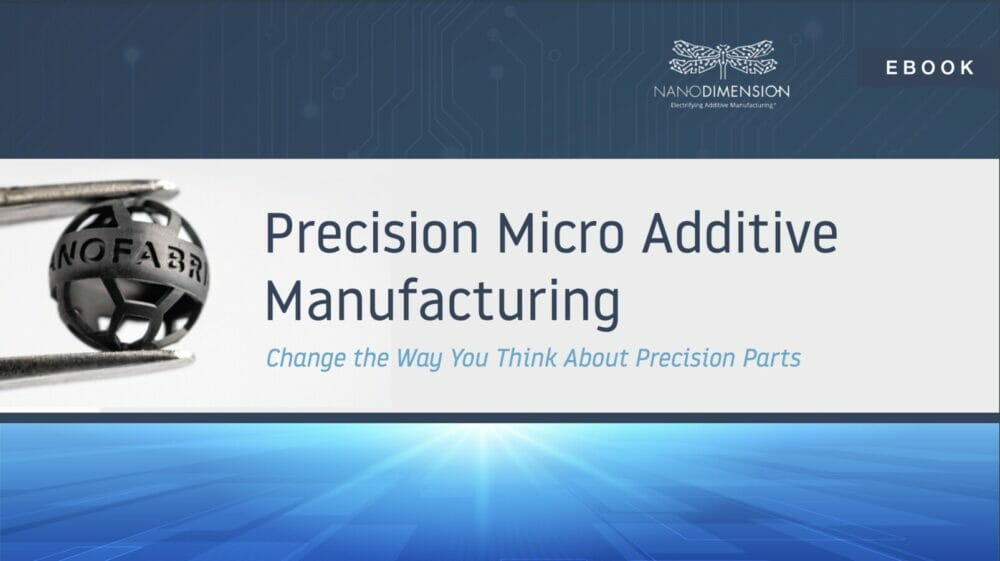Jon Donner, General Manager, Fabrica Group, Nano Dimension
Working at the vanguard of micro additive manufacturing (AM) for so many years, I have had the time reflect about the role this technology will have on the future of precision manufacturing. AM has been seen as a disruptive technology ever since it came onto the scene nearly 30 years ago. First it disrupted the prototyping stage of product development, back in the day the technology that we refer to as AM today being widely known as “rapid prototyping”. More recently, AM has disrupted manufacturing itself, and is now a production technology that in many situations is a cost-effective and speedy alternative to legacy manufacturing processes, which at the same time stimulates the development of geometrically complex and innovative parts and components and which promotes mass customization.
In the area of precision / micro manufacturing, however, until recently, AM has struggled to find a foothold, in no small part due to an inherent lack of precision in industrial AM processes which could only be overcome by prohibitively expensive and extremely slow platforms. With the industry-wide drive towards miniaturization of parts and components, the need for a viable, cost-effective, and speedy micro-AM process was obvious, and was the key driver behind the development of the now commercially successful Fabrica 2.0 precision micro AM technology.


Through this technology, I feel that it is appropriate to say that manufacturers can now truly re-imaging the way that they produce precision micro parts and components, and that the Fabrica 2.0 has changed the economics of manufacturing. This is something that can now be demonstrated in numerous industry sectors across the world, and which is described in a new eBook just released and available HERE entitled, “Precision Micro Additive Manufacturing – Change the Way You Think About Precision Parts”.
MICRO PRECISION
The key driver behind the Fabrica 2.0’s ability to change the economics of manufacturing is the levels of precision that it can achieve, which for the first time allows a micro-AM process to rival the tolerances that can be achieved via micro molding. As an AM process, this level of precision is accompanied by a host of additional benefits, all of which combine to reduce the prototyping and product development time for micro parts and components or indeed micro molds.
With the Fabrica 2.0, 1 micron resolution is now attainable, and the technology builds “additively” in 1.5 micron layers. With this breakthrough, the path to the creation of innovative miniaturized parts at amazing speed and reduced cost is open for all industry sectors.
WHAT THIS MEANS FOR YOU
The Fabrica 2.0 micro-AM technology is a true blue-ocean technology, meaning that in essence it brings AM into new markets and enables new applications. For the first time, manufacturers that require micron and sub-micron level accuracy and resolution have an AM technology available, and so for the first time, these manufacturers have the ability to benefit from the inherent advantages of the AM process.
Perhaps of key interest is the fact that AM is relatively agnostic to part complexity, and it is possible to design and manufacture unique geometries. As such, the Fabrica 2.0 technology becomes an enabling technology, and a true stimulator of innovation, making the manufacture of parts and features previously impossible, possible.
AM also requires no set up costs. The tooling required for traditional manufacturing processes not only has a negative impact on time to market, but also makes such processes uneconomic for small or medium sized production runs. For AM technologies, small and medium sized runs are cost-effective, and indeed it is fair to say that today, represent the sweet spot for the technology.
Add into the mix that AM allows for mass customisation, personalization, and the ability to use the same manufacturing platform for prototyping, small batches, and mass manufacturing, and you begin to see the myriad of possibilities that now exist for micro manufacturers.
MICRONS IN HOURS
That all sounds amazing, but what does it actually mean for you?
In the eBook, you will find details of real-time case studies that show how manufacturers have benefitted from using the Fabrica 2.0 in terms of innovation, and cost and time-to-market reductions. But in general terms, success through the use of the Fabrica 2.0 is measured in microns and hours. Micron-level detail can be achieved without the need to fabricate tools, and this means that you can have intricate and geometrically complex prototypes in a matter of hours.
There is a limit to the ability to create complicated parts using traditional micro tooling. With increased complexity comes increased cost, but not when using the Fabrica 2.0 micro AM technology, the absence of the requirement for a physical tool lifts the lid for design engineers to think out of the box and attain design goals previously unimaginable. This design freedom coupled with the inherent manufacturing agility that is a core characteristic of AM require a root and branch re-assessment of all aspects of the product development process, a disruption that is a spur to the stimulation of future product successes and enhanced market-share and profitability.
Through the use of the Fabrica 2.0, you can also optimize workflow, the technology producing less scrap and fewer tools than conventional manufacturing processes. It also promotes the reduction of iterative process, assembly, and inventory. This means that significant operational cost benefits are now attainable at the micro manufacturing level.
HOW IT WORKS
The Fabrica 2.0 is based on the Digital Light Processor (DLP) engine uniquely combined with the use of adaptive optics. In conjunction with an array of sensors, this allows for a closed feedback loop, which enables the attainment of micron-level accuracy while remaining cost-effective as a manufacturing solution. Adaptive optics have been used in other areas of technology, but this is the first time that they have been applied to an AM technology.
When looking at the software used, the Fabrica 2.0 also has a multi-resolution strategy, meaning that the parts where fine details are required are printed relatively slowly, but in the areas where the details aren’t so exacting, the part is printed at a speeds 10 to 100 times faster. It also uses an algorithm family which focuses on file preparation, optimizing parameters such as print angle build plate, supports etc…, which once again ensure a precise, optimized, and reliable print process.
WHAT’S INSIDE?
Alongside the development of the Fabrica 2.0 platform, much work has been undertaken on materials development, and we now have a number of materials that are being used commercially. The two key materials we use are our Precision N-800 material which is ABS-like and combines strength and flexibility. There are countless applications for this engineering material, and it is an ideal material of choice for structural applications, across various industries such as electronics, optics, automotive, aerospace, and many more. Our Precision N-900 is a ceramic loaded material achieving 1 micron resolutions with nearly 100% ceramic, and is high-temperature tolerant with enhanced mechanical properties and recommended for outdoor applications. Precision N-900 offers high wear resistance for longevity for enhanced performance in mechanical assemblies.
SUMMARY
As detailed in the newly released eBook, the key to the success of the Fabrica 2.0 micro-AM technology is that it brings the benefits of AM to micro manufacturers for the first time, including hitherto impossible part complexity (enhancing design and functionality), no tooling costs, minimal set up costs, and the ability to mass customise and personalise products. As a versatile technology appropriate for prototyping, small batches, and mass manufacturing, the technology is now stimulating innovation in the micro manufacturing sector, and is truly changing the economics of manufacturing.








